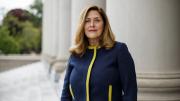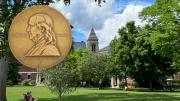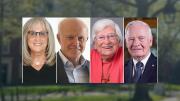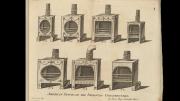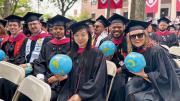A New Look at Legacies
Amherst College announced in October that it will end the alumni preference in its admissions decisions. “[C]hildren of alumni who are academically well-qualified” make up about 11 percent of each class now, it said, but “Going forward, legacy status will no longer factor into the College’s holistic admission process, creating greater opportunity for more applicants.” President Biddy Martin said, “Now is the time to end this historic program that inadvertently limits educational opportunity….”
There is a bit of a groundswell about the issue. The same month, Johns Hopkins president Ronald J. Daniels editorialized in The Chronicle of Higher Education, “End Legacy Admissions Now: Hereditary advantage has no place in higher ed.” (His institution has the luxury of fully endowed undergraduate financial aid, thanks to a $1.8-billion gift from alumnus Michael R. Bloomberg, M.B.A. ’66, LL.D. ’14.) Viet Nguyen, a Brown graduate now pursuing degrees at Harvard Business School and Stanford, has begun a movement urging young alumni to withhold gifts from their alma maters until they abolish legacy preferences, which he calls “inherently unjust.” Yale’s College Council passed a resolution calling on that institution to end the practice, according to the Yale Daily News, but its admissions director defended the “current policy of adding a plus factor to sons or daughters of Yale alumni.” During its $7-billion capital campaign, one suspects, Yale would be loath to change.
The issue has long been debated at Harvard, too—more publicly since the disclosure of admissions preferences during the Students for Fair Admissions anti-affirmative action litigation against the College (see “What Legacy?” January-February 2019, page 5). Even as the University ardently defends affirmative action in holistic admissions processes, and intensifies its efforts to enroll more lower-income and first-generation students, President Lawrence S. Bacow has made the case for legacy preferences: “This place did not build itself,” he has said. Prior generations donated “to create the institution that exists today,” enabling it to advance research and educate new student cohorts. “Each generation helps the next,” he continued, and “it is important to continue to try to ensure that we have that kind of loyalty and resources.…Is it surprising that we recognize people like that?” In doing so via an admissions preference, he observed, “Legacies are, as a group, arguably the most qualified applicants…by any measure.”
That should be the case: highly educated parents are motivated to secure the benefits of such schooling for their progeny. In a society split socioeconomically, critics of legacies note, those fortunate elders have means to bring to bear on the challenge, thus replicating inequality.
Amherst’s action may stand alone, or, in the current environment, may become the start of something bigger. Of local interest, Biddy Martin has been a Harvard Corporation member since 2018, and so may bring to its deliberations a different perspective from about 90 miles to the west.
Climate Change on Campus(es)
As various schools pursue divestment of fossil-fuel investments in their endowments (among those announcing such decisions were California State University, Dartmouth, and Vassar), attention has turned to campus sustainability efforts. Harvard’s most recent report (https://report.green.harvard.edu), updated October 15, shows campus greenhouse gas emissions holding even during 2020 at 197,000 metric tons of carbon dioxide equivalent (MTCDE), essentially the level maintained since 2016.
Yale, which ambitiously aims to achieve “net-zero” carbon emissions by 2035 (purchasing carbon offsets as necessary), and actual emissions of zero by 2050, detailed the steps required to achieve its goal: moving toward fully electrified heating for building campuswide; reducing emissions by using space more efficiently; and new-construction standards that rely on geothermal wells, heat pumps, and rooftop photovoltaic solar systems (with biomass gasification and green hydrogen coming online in the next decade). Yale estimated capital costs of $1.5 billion during the next three decades to effect its aims. As a partial means of funding the program, it is modifying its internal carbon charge so that the revenue generated by assessing each budget unit for its emissions (rising from $20/MTCDE in fiscal year 2023 to $50 in 2025) will be used to defray 10 percent of the investments required to reduce such emissions. Yale is increasing annual capital expenditures for emission reductions from $15 million to $25 million.
Admissions Litigation
Even as Students for Fair Admissions (SFFA) awaits word on whether the Supreme Court will hear its appeal of its thus-far unsuccessful litigation against Harvard over the consideration of race in holistic admission reviews, the anti-affirmative action group lost a similar case against the University of North Carolina. In October, Judge Loretta C. Biggs, of the U.S. District Court for the Middle District of North Carolina, ruled that “UNC has met its burden of demonstrating with clarity that its undergraduate admissions program withstands strict scrutiny and is therefore constitutionally permissible.” She cited its compelling interest in the educational benefits of diversity, careful, “narrowly tailored” processes, and sincere consideration of alternative means to achieve its aims (read more at harvardmag.com/unc-case-appeal-21).
Edward Blum, who has organized and pursued the lawsuits (and others against Yale and the University of Texas), in November asked the Supreme Court to hear the Harvard and UNC cases together, even though the latter has not yet proceeded from the district level to the federal appeals court, a maneuver called “certiorari before judgment.” If the Court hears both cases, it could determine whether to mandate different admissions procedures by public and private universities—or if it wishes to uphold or overturn affirmative action broadly.
[After this issue went to press, the U.S. Solicitor General, presenting the views of the Biden administration as requested by the Supreme Court, urged the Court not to hear the SFFA appeal of the Harvard admissions case.]
Life-Sciences Prowess
As evidence of the University’s scholarly reach in life sciences and public health, a dozen new members of the National Academy of Medicine are Harvard affiliates: Monica M. Bertagnolli, Wilson M.D. professor of surgery; David Clapham, Castañeda professor of cardiovascular research, emeritus, and professor of neurobiology; Joseph Gone, professor of global health and social medicine and professor of anthropology; William C. Hahn, Rosenberg professor of medicine; Zhigang He, professor of neurology and ophthalmology; Kenneth David Mandl, Lindberg professor of pediatrics and biomedical informatics; Vamsi K. Mootha, professor of systems biology; Jane Wimpfheimer Newburger, Commonwealth professor of pediatrics; Eric J. Rubin, editor-in-chief, New England Journal of Medicine; Renee N. Salas, affiliated faculty, Harvard Global Health Institute; Thomas Sequist, professor of medicine and health care policy; and Reisa Sperling, professor of neurology. Details about each are available at harvardmag.com/academy-medicine-21.
Seven affiliates were named Howard Hughes Medical Institute investigators; each receives $9 million in research funding: Emily Balskus, professor of chemistry and chemical biology; Flaminia Catteruccia, professor of immunology and infectious diseases; Cassandra Extavour, professor of organismic and evolutionary biology and of molecular and cellular biology; Chenghua Gu, professor of neurobiology; Sun Hur, professor of biological chemistry and molecular pharmacology, Schloss professor of pediatrics, and professor of biological chemistry and molecular pharmacology; Cigall Kadoch, associate professor of pediatrics; and Shingo Kajimura, associate professor of medicine. Their work is detailed at harvardmag.com/hhmi-21.
